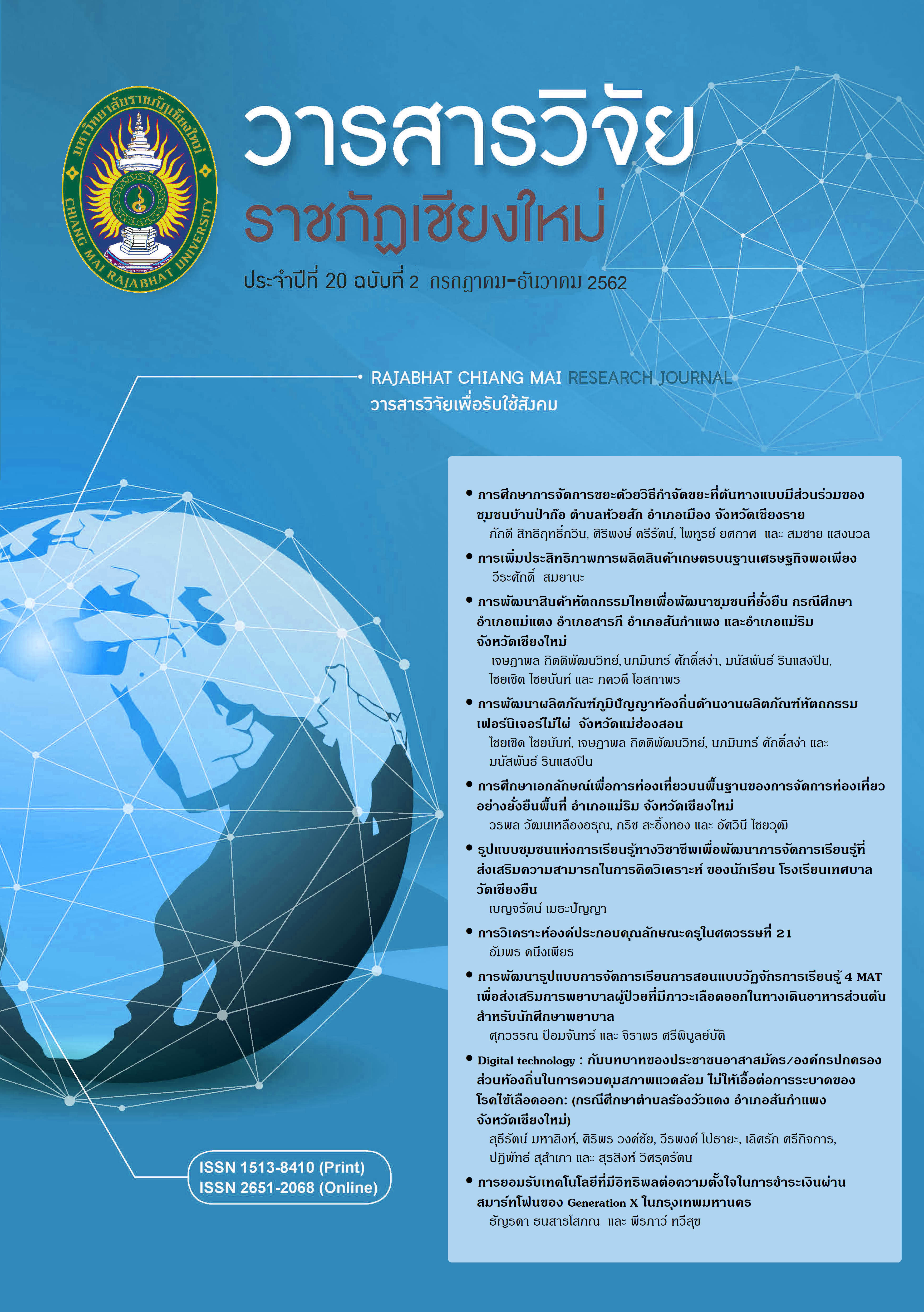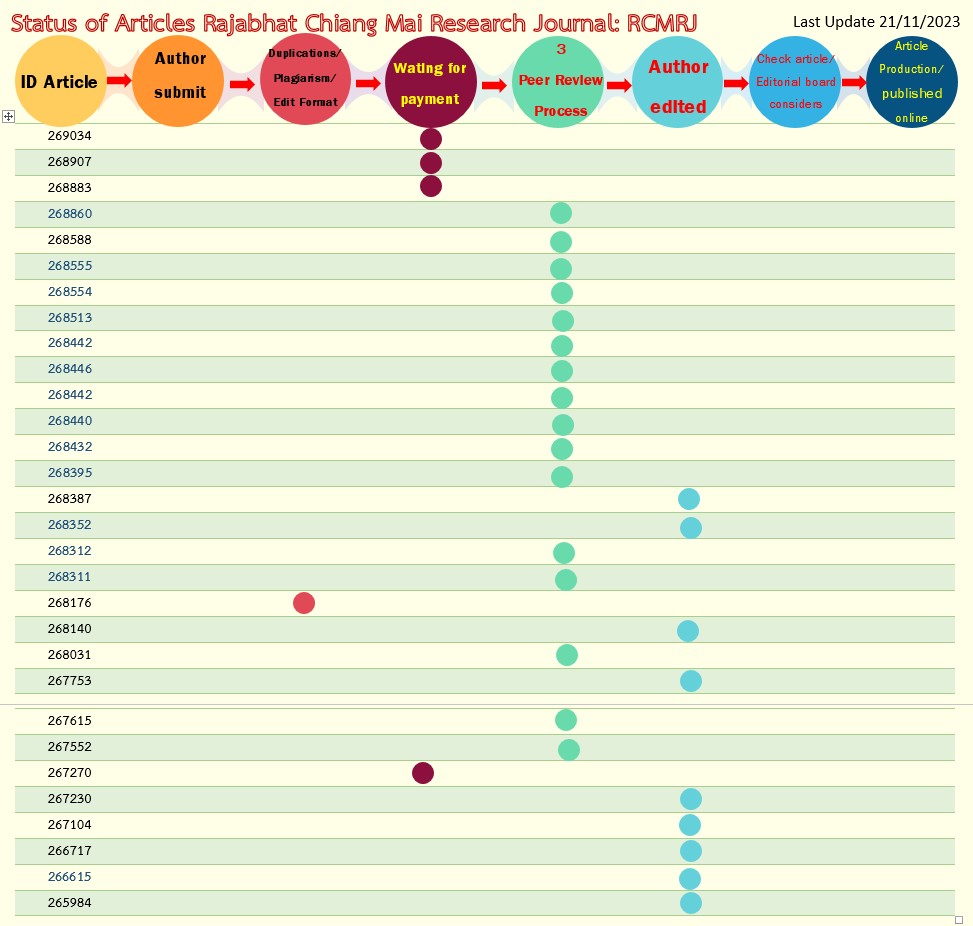Enhancing the Effectiveness for Agricultural Production Base on Sufficiency Economy Philosophy
DOI:
https://doi.org/10.14456/rcmrj.2019.207948Keywords:
Efficiency, ASEAN community, Sufficiency economy philosophyAbstract
This research aims to find ways to enhance the effectiveness of agricultural production of the community in Chiang Mai province population 207subdistrict organizations. The community has the potential on Sufficiency Economy Philosophy (SEP). The qualitative research was to analyze the community context of samples 10 subdistrict organizations using SWOT analysis in order to determine the factors that promote or hinder the potential of the group. The focus group is a qualitative method used to find ways to increase the productivity of farmers. The quantitative analysis of soil nutrient values includes a comparative performance measurement by produetion efficiency before and after the implementation of the SEP to the major crops in Chiang Mai, namely, longan, passion fruit, onion, and riceberry. The research found that the potential agricultural production groups in Chiang Mai could apply SEP in three guidelines; 1) Soil management, nutrient analysis of soil found that the soil is fertile ground for production. Thus, the soil is slightly improved using organic fertilizer from the agricultural residues in the community to reduce agricultural expenditure. 2) Increase productivity, all farmer groups have the production techniques in crop types, soil management, pest management, and development to full-scale organic farming. 3) Reduce costs in order to increase production efficiency. The research could enhance the average productivity by 46.95% split according to the type of agricultural products. The most effective production value of passion fruit is 73.39%, followed by the production efficiency values of longan (59.36%), onion (42.32%), and riceberry (12.74%). These study can enhancing the efficiency for agriculture production.
References
กระทรวงเกษตรและสหกรณ์. (2559). แผนพัฒนาการเกษตร ในช่วงแผนพัฒนาเศรษฐกิจและสังคมแห่งชาติฉบับที่ 12 (พ.ศ. 2560-2564). สืบค้นจาก http://www.oae.go.th/download/journal/development_plan2559.pdf
กุศล ทองงาม. (2547). ประสิทธิภาพการผลิตของเกษตรกรผู้ปลูกข้าวนาชลประทานและนาน้ำฝนจังหวัดเชียงใหม่ เชียงราย. เชียงใหม่ : ศูนย์วิจัยเพื่อเพิ่มผลผลิตทางเกษตร คณะเกษตรศาสตร์ มหาวิทยาลัยเชียงใหม่.
จิราพร ปาลี, กมล งามสมสุข, และเยาวเรศ เชาวน์พูนผล. (2555). การวิเคราะห์ประสิทธิภาพทางเทคนิคการผลิตข้าวเหนียวในอำเภอหางดงและอำเภอสันป่าตอง จังหวัดเชียงใหม่. วิทยานิพนธ์ สาขาวิชาเศรษฐศาสตร์เกษตร มหาวิทยาลัยเชียงใหม่.
นันทิยา หุตานุวัตร. (2546). SWOT การวางแผนกลยุทธ์ธุรกิจชุมชน: คณะเกษตรศาสตร์ มหาวิทยาลัยอุบลราชธานี สถาบันชุมชนท้องถิ่นพัฒนา. สืบค้นจาก http://www.jit-jai-d.blogspot.com/2007/08/swot.html
เบญจมาศ สันต์สวัสดิ์ และปภากร สุทธิภาศิลป์. (2562). การส่งเสริมการผลิตสินค้าเกษตรอินทรีย์ในชุมชนจังหวัดเชียงใหม่ให้มีศักยภาพการแข่งขันในประชาคมอาเซียน. วารสารวิจัยราชภัฏเชียงใหม่, 20(1), 20-29.
แผนพัฒนาเศรษฐกิจและสังคมแห่งชาติ. (2560). สรุปสาระสำคัญแผนพัฒนาเศรษฐกิจและสังคมแห่งชาติ ฉบับที่ 12. สืบค้นจาก http://www.nesdb.go.th/download/plan12/สรุปสาระสำคัญแผนพัฒนาเศรษฐกิจและสังคมแห่งชาติฉบับที่12.pdf
แผนยุทธศาสตร์จังหวัดเชียงใหม่. (2561). ยุทธศาสตร์ 5 ยุทธศาสตร์. สืบค้นจาก http://www.dla.go.th/upload/ebook/column/2013/6/2076_5347.pdf
พรชัย เจดามาน. (2556). การจัดการทรัพยากรมนุษย์ โดยใช้หัวใจและมันสมอง. สืบค้นจาก http://oknation.nationtv.tv/blog/jedaman/2013/01/31/entry-2
สุรพงษ์ เจียสกุล. (2560). แนวโน้ม ทิศทางการพัฒนาภาคเกษตรไทย. สืบค้นจาก http://www2.oae.go.th/FTA/PDF/news/24-5-59/1.pdf
สำนักงานคณะกรรมการพัฒนาการเศรษฐกิจและสังคมแห่งชาติ. (2561). GDP ไตรมาสสาม ปี 2560 และแนวโน้ม ปี 2560 - 2561. สืบค้นจาก www.nesdb.go.th/ewt_dl_link.php?nid=5165
สำนักงานเศรษฐกิจการเกษตร. (2561). รายงานภาวะเศรษฐกิจการเกษตรไตรมาส 3 ปี 2560 และแนวโน้มปี 2560-2561. สืบค้นจาก https://www.nesdb.go.th/ewt_dl_link.php?nid=7310
Cooper, W.W, Seiford, L.M & Tone, K. (2000) Data envelopment analysis: A comprehensive text with models,applications, references and DEA–Solver Software. (pp.193-197). Boston/Dordrecht/London: Kluwer Academic.
L.O. Akhilomen and group. (2015). Economic Efficiency Analysis of Pineapple Production in Edo State, Nigeria: A Stochastic Frontier Production Approach. American Journal of Experimental Agriculture, 5(3), 267-280.
The World Bank. (2017). Agriculture value added per worker (constant 2010 US$). (online). https://data.worldbank.org/indicator/EA.PRD.AGRI.KD
Downloads
Published
How to Cite
Issue
Section
License
1. Articles, information, content, images, etc. that are published in "Chiang Mai Rajabhat Research Journal" is the copyright of Chiang Mai Rajabhat Research Journal. Chiang Mai Rajabhat University. If any person or organization wants to distribute all or any part of it or do any action Must have written permission from the Chiang Mai Rajabhat Research Journal, Chiang Mai Rajabhat University.
2. Content of articles appearing in the journal is the responsibility of the author of the article. The journal editor is not required to agree or take any responsibility.














